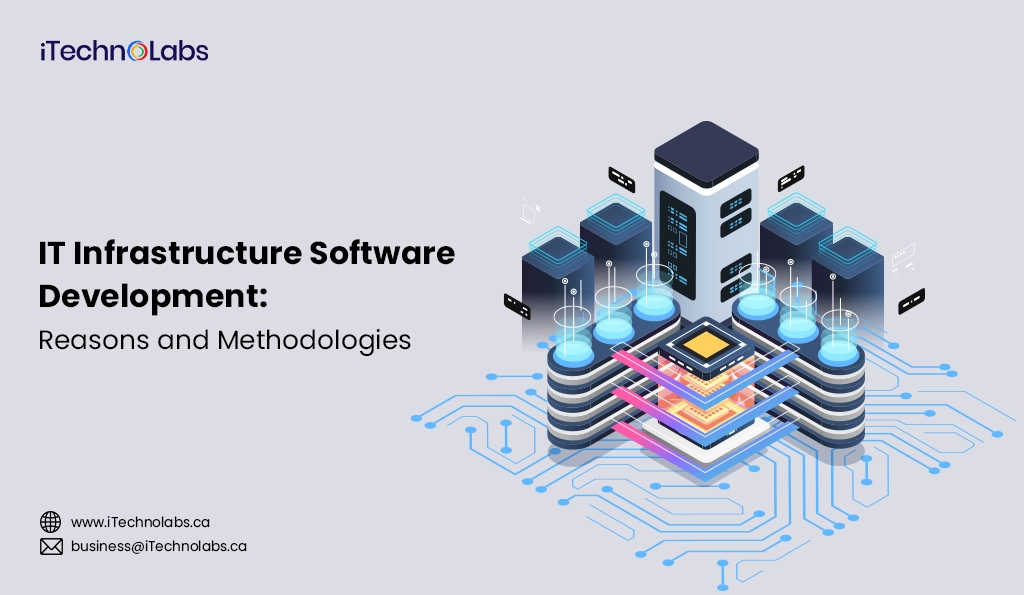Introduction
IT infrastructure is undeniably the backbone of any successful organization, acting as the critical foundation for all technology-driven operations. This infrastructure is vital, supporting and significantly enhancing the delivery of products and services to customers. It ensures that businesses can operate efficiently and effectively in a digital world, where technology is constantly advancing. Within the realm of IT infrastructure, software development emerges as a pivotal component, playing a crucial role. It is through innovative software solutions that businesses can truly differentiate themselves in a crowded market, streamline their operations, and maintain a competitive edge in today’s rapidly evolving digital landscape.
This article aims to dive deeper into the importance of IT infrastructure and software development, shedding light on the crucial role these elements play in the success of modern businesses. We will uncover the reasons why investing in robust IT infrastructure and focusing on cutting-edge software development are not just beneficial but essential for any business aiming to thrive in the current digital era. Additionally, we will explore various methodologies and frameworks that organizations can adopt to ensure their software development processes are not only efficient but also perfectly aligned with their strategic goals. This includes agile development practices, DevOps methodologies, and continuous integration and continuous deployment (CI/CD) pipelines, which can dramatically improve the speed, quality, and responsiveness of software development efforts.
By understanding these dynamics, businesses can better position themselves to leverage technology for growth and sustainability in the digital age. We will also discuss the importance of cybersecurity measures within IT infrastructure, highlighting how protecting data and systems against cyber threats is integral to maintaining trust and reliability. Finally, the role of cloud computing in modern IT infrastructure will be examined, illustrating how it offers scalability, flexibility, and cost-efficiency, further empowering businesses to innovate and adapt to market demands.
Types of IT Infrastructure
There are various types of IT infrastructure that organizations can adopt, depending on their specific needs and goals. These include:
Traditional Infrastructure
Traditional infrastructure, often referred to as on-premise systems and hardware, signifies that all critical technology components are physically located within the organization’s premises, as opposed to being hosted on the cloud. This setup includes but is not limited to, servers, storage devices, networking equipment, and other essential hardware crucial for the daily operations of the organization’s IT systems. These components work in unison to ensure the smooth execution of various IT-related tasks and services.
Maintaining such an infrastructure requires regular, sometimes even daily, maintenance and timely updates. These tasks fall under the responsibility of dedicated IT teams within the organization. These highly skilled professionals are tasked with the ongoing job of ensuring that all components are operating at their optimal capacity. They are also responsible for swiftly addressing any technical issues that might arise, thereby minimizing downtime and maintaining productivity. Furthermore, these teams play a crucial role in updating systems and applying patches to protect the organization against new and evolving security vulnerabilities.
Adopting this model of infrastructure allows organizations to have direct control over their IT environment. This control includes the ability to immediately address and rectify any issues without the dependency on external service providers. However, this level of control and self-reliance comes with its own set of challenges. It requires a significant investment not only in the physical components but also in the skilled personnel needed to maintain and manage them. Organizations must also ensure they have the necessary space for housing these components and the infrastructure to support them, such as cooling systems and secure facilities.
Cloud Infrastructure
As technology continues to evolve, organizations are increasingly turning towards cloud infrastructure as an alternative to traditional on-premise systems. Cloud infrastructure refers to the delivery of computing resources over the Internet on a pay-per-use basis. This includes servers, storage, networking, and software services.
The main advantage of adopting a cloud infrastructure is its scalability. Organizations can easily scale up or down based on their needs, without having to worry about investing in additional hardware or maintenance costs. This allows for more flexibility and cost-efficiency, as organizations only pay for the resources they use.
Another benefit of cloud infrastructure is its accessibility. With data and applications stored in the cloud, employees can access them from anywhere with an internet connection. This promotes collaboration and remote work capabilities, which is especially important in today’s global and mobile workforce.
Hyper-Converged Infrastructure (HCI)
Hyper Converged infrastructure (HCI) is another emerging technology that combines compute, storage, and networking resources into a single software-defined system. This integrated approach eliminates the need for separate components and simplifies management.
One of the main benefits of HCI is its ability to scale quickly and easily. Organizations can add nodes as needed without disrupting operations or incurring significant costs. Additionally, the centralized management of HCI allows for better control and efficiency.
Another advantage of HCI is its flexibility. With a software-defined infrastructure, organizations can easily adjust resources to meet changing demands and workloads. This can lead to cost savings as well, as there’s no need to purchase excess hardware that may go unused.
Also Read: Top IT Outsourcing Services
Why IT Infrastructure Software Development Matters
IT infrastructure software development plays a crucial role in enabling organizations to leverage the benefits of cloud and HCI technologies. With custom-built software, companies can tailor their infrastructure to their specific needs and goals.
Moreover, IT infrastructure software development allows for automation and orchestration of tasks, reducing manual labor and human error. This leads to increased efficiency, cost savings, and improved overall performance.
Scalability and Flexibility
Custom-built infrastructure software not only offers exceptional scalability and flexibility but also empowers organizations to effortlessly adapt to fluctuating business requirements and emerging technology trends. This bespoke approach ensures that as a company’s needs shift or expand, the software can be fine-tuned accordingly. By having the capability to seamlessly add or subtract features based on current demands, organizations are better positioned to utilize their resources efficiently. This strategic agility is invaluable in maintaining a competitive edge within the fast-paced, ever-evolving marketplace, allowing companies to respond swiftly to industry changes without compromising on performance or productivity.
Agility and Flexibility: A Recipe for Success
In today’s digital landscape, agility and flexibility are vital components to any organization’s success. With infrastructure software development, companies can stay ahead of the curve by continuously adapting to shifting market conditions and customer demands. This ensures that they remain competitive in a dynamic business environment.
Additionally, with the ability to rapidly adjust resources and capabilities, organizations can respond quickly to unexpected challenges, minimizing disruptions and maximizing productivity. This agility also allows for experimentation and innovation, as companies can easily test new technologies and strategies without being bound by rigid infrastructure.
Integration and Interoperability: Connecting the Dots
Another key benefit of infrastructure software is its ability to integrate and communicate with other systems within an organization. This ensures seamless data flow and collaboration across different departments, eliminating silos and promoting a more cohesive work environment.
Furthermore, with the rise of cloud computing and digital transformation, the need for interoperability has become even more critical. Infrastructure software enables organizations to connect their on-premise systems with cloud-based applications, creating a hybrid IT environment that combines the best of both worlds.
Improved Decision Making: Data-Driven Insights
Infrastructure software also plays a crucial role in providing organizations with valuable data and insights. With the help of advanced analytics and reporting tools, companies can gain a better understanding of their operations, customer behavior, market trends, and more.
By leveraging this information, organizations can make informed decisions that drive growth and efficiency. This is especially important in today’s data-driven business landscape, where the ability to analyze and act upon data can give companies a competitive advantage.
Innovation and Differentiation: Staying Ahead of the Curve
In today’s fast-paced and ever-changing business landscape, the importance of innovation cannot be overstated. It is the linchpin that enables companies to outmaneuver and outperform their competitors. Central to this capacity for innovation is the role of infrastructure software, which empowers organizations to seamlessly adopt new technologies and processes, facilitating not just adaptation but continuous improvement and distinct market differentiation.
As the technological landscape evolves, tools like automation, machine learning, and artificial intelligence are becoming increasingly integral to infrastructure software. These technologies are no longer futuristic concepts but practical tools that, when effectively integrated into business operations, can significantly enhance efficiency and productivity. Companies that leverage these cutting-edge technologies can not only streamline their processes but also drive substantial innovation and disruption in their respective industries. By harnessing the power of advanced infrastructure software, businesses are better positioned to anticipate market trends, respond to customer needs with agility, and maintain a competitive edge that is critical for success in today’s dynamic business environment.
Enhanced Customer Experience: Meeting and Exceeding Expectations
In addition to driving innovation, infrastructure software plays a crucial role in enhancing the customer experience. With advancements in technology, customers have become more demanding and expect a seamless and personalized experience from companies. Infrastructure software enables organizations to meet these expectations by providing tools like data analytics, customer relationship management (CRM) systems, and omnichannel communication platforms. These tools allow businesses to gather and analyze customer data, understand their needs and preferences, and tailor their products or services accordingly. By leveraging infrastructure software, companies can create a seamless customer experience that meets and even exceeds expectations, leading to improved customer satisfaction and loyalty.
Cost Efficiency and Scalability: Doing More with Less
Gone are the days when companies had to invest heavily in physical infrastructure and resources. With advanced infrastructure software, businesses can achieve cost efficiency by reducing their hardware and maintenance costs. Through virtualization and cloud computing, organizations can run multiple applications on a single server, eliminating the need for expensive hardware and its associated maintenance costs. Moreover, infrastructure software enables scalability, allowing businesses to easily adjust their resources and capabilities based on their needs. This flexibility is especially beneficial for startups and small businesses that can now access the same technology and capabilities as larger organizations without incurring significant costs.
Enhanced Security and Compliance
In today’s digital landscape, cyber threats are a major concern for businesses. Infrastructure software comes equipped with advanced security features like firewalls, intrusion detection systems, and data encryption to protect organizations from cyber attacks. With continuous updates and monitoring, these tools provide a robust defense against potential security breaches. Additionally, infrastructure software helps ensure compliance with industry regulations by providing features such as audit trails and access controls. This not only helps businesses avoid penalties but also builds trust with customers who are increasingly concerned about their data privacy.
How to Develop IT Infrastructure Software?
Developing infrastructure software requires a deep understanding of the organization’s needs, current technology landscape, and future goals. The following are some key steps to consider when developing IT infrastructure software:
Define Requirements
The initial phase in crafting infrastructure software encompasses a meticulous delineation of the prerequisites. This critical step requires a deep dive into comprehending the organization’s extant IT framework, pinpointing existing challenges, and projecting the demands of the future. A comprehensive evaluation of the current processes and systems is indispensable, as it sheds light on potential areas ripe for enhancement. By conducting such an analysis, developers can unearth opportunities where automation or seamless integration could significantly elevate operational efficiency. This foundational understanding not only helps in tailoring the software to fit the organization’s unique needs but also sets the stage for a more streamlined and effective deployment of technology solutions.
Choose the Right Development Methodology
Selecting the right development methodology is crucial, as it can significantly impact the success of infrastructure software. Different methodologies, such as waterfall or agile, have their advantages and disadvantages depending on the project’s complexity and requirements. Agile methodologies are often favored for infrastructure software development due to their iterative nature, allowing for continuous improvement and adaptability to changing needs. Whichever methodology is chosen, it is essential to have a well-defined project plan and timeline in place to ensure the timely delivery of the software.
Select Tech Stack
The tech stack refers to the combination of programming languages, frameworks, and tools used in developing software. For infrastructure software, it is essential to carefully select a tech stack that aligns with the organization’s existing technology landscape and future growth plans. This involves considering factors such as compatibility, scalability, security, and support for integration with other systems. Additionally, it is crucial to stay updated with the latest advancements in technology and regularly reassess the tech stack to ensure it meets the organization’s evolving needs.
Development and Integration
Infrastructure software development involves creating a robust and reliable system that can seamlessly integrate with other existing systems. This requires careful planning, collaboration, and testing to ensure the smooth integration of the new software into the organization’s IT ecosystem. It is crucial to involve all relevant stakeholders in this process to gather their feedback and address any potential challenges or conflicts early on.
Testing and Quality Assurance
As infrastructure software is critical to the functioning of an organization, it must undergo thorough testing and quality assurance processes. This includes unit testing, integration testing, performance testing, and security testing to ensure that the software meets all functional and non-functional requirements. Additionally, continuous monitoring and troubleshooting are essential to detect any issues or bugs in the system promptly.
Deploy and Monitor
Once the software has been developed, integrated, and thoroughly tested, it is ready to be deployed in a production environment. This involves carefully planning the deployment process to minimize any potential disruptions to the organization’s operations. After the deployment, regular monitoring and maintenance are crucial to ensure the software continues to function optimally and address any issues that may arise.
IT Infrastructure Management
Effective IT infrastructure management plays a pivotal role in ensuring the seamless operation and maintenance of an organization’s technological backbone. This multifaceted task encompasses the meticulous management of hardware components, software applications, networking systems, data storage solutions, and cybersecurity measures. The goal is to guarantee that all these elements function in harmony, providing a robust and reliable IT environment. Moreover, this process involves a continuous cycle of evaluation and updates to the infrastructure. By doing so, it addresses the organization’s evolving requirements and integrates emerging technologies, thereby maintaining operational excellence and supporting the organization’s strategic objectives in a rapidly changing technological landscape.
Read More: Selecting the Optimal IT Consulting Services and Partner for Your Enterprise
IT Infrastructure Software Development Costs
Building and maintaining a robust IT infrastructure is a complex task that demands substantial investments in software development. These investments are multifaceted, encompassing not just the initial design and development phase of the application but also its continued maintenance, support, and routine updates to keep up with evolving technology trends and security threats. In addition to these direct costs, organizations must also account for hidden expenses that often emerge unexpectedly. These can include the need for hardware upgrades to support new software, implementing advanced cybersecurity measures to protect against increasing cyber threats, and other unforeseen expenditures that can arise from compliance requirements or integration challenges with existing systems.
Therefore, it becomes imperative for businesses to conduct a comprehensive evaluation of the total cost of ownership (TCO) when planning for IT infrastructure software development. This evaluation should include a detailed analysis of both direct and indirect costs over the software’s lifecycle, allowing for a more accurate prediction of the financial investment required. By understanding the full spectrum of costs associated with the development, maintenance, and enhancement of IT infrastructure, organizations can make informed decisions that align with their strategic objectives and financial capabilities. This careful planning and budgeting are crucial for ensuring the long-term sustainability and scalability of their IT systems, ultimately supporting the organization’s growth and competitive edge in the market.
Common Challenges with IT Infrastructure Software Development and Ways to Address Them
Along with the financial aspects, there are also common challenges that arise during IT infrastructure software development. These can include technical difficulties, project management issues, and inadequate communication between stakeholders. To ensure a successful outcome, businesses must proactively identify and address these challenges throughout the development process.
One of the most significant obstacles in IT infrastructure software development is managing complexity. As technology continues to evolve and systems become more interconnected, the complexity of IT infrastructure grows exponentially. This complexity can lead to difficulties in system integration, performance optimization, and maintenance.
Complexity of Integration
With the ever-increasing number of applications and systems being used in organizations, integrating them into a cohesive IT infrastructure can be a daunting task. Many businesses struggle with integrating legacy systems with newer technologies or merging multiple systems after mergers or acquisitions. This complexity can result in delays and increased costs during development.
To address this challenge, organizations should invest in modern integration tools and techniques, such as API management platforms and microservices architecture. These tools can help streamline the integration process by providing a standardized approach and simplifying the communication between systems.
Lack of Scalability
Another common challenge in IT infrastructure software development is ensuring scalability. Many businesses start with a small-scale IT infrastructure but struggle to expand it as their needs grow. This can lead to performance issues and increased maintenance costs.
To address this, organizations should consider scalability from the initial stages of development. They should design their infrastructure with future growth in mind and regularly assess its capacity to handle increasing demands. Cloud-based solutions can also help with scalability by providing on-demand resources and flexibility to scale up or down as needed.
Security and Compliance
With the rise of cyber threats, security has become a top concern for organizations. IT infrastructure plays a critical role in protecting sensitive data and ensuring compliance with regulations such as GDPR and HIPAA. However, ensuring security and compliance can be challenging due to the complexity of modern IT systems.
To address this challenge, businesses should prioritize security from the initial stages of development. They should implement robust security measures, such as encryption and access controls, and regularly conduct security audits. Additionally, organizations should stay up to date with the latest regulations and ensure their infrastructure meets compliance requirements.
Resource Constraints
Limited resources, such as budget and skilled personnel, can also pose a challenge in IT infrastructure development. Building and maintaining complex systems require significant investments, which may not be feasible for small businesses.
To overcome this challenge, organizations should prioritize their needs and invest in essential infrastructure components. They can also consider outsourcing certain tasks or utilizing open-source solutions to reduce costs. Regular training and upskilling of existing personnel can also help in overcoming resource constraints.
How can iTechnolabs help you to build IT Infrastructure Software?
At iTechnolabs, our team boasts a wealth of experience in crafting and overseeing IT infrastructure for a diverse array of organizations. Our expertise spans across numerous industries, equipping us with the knowledge to tackle unique challenges. We provide a comprehensive suite of services designed to assist businesses in constructing robust and scalable IT systems tailored to their specific requirements. From initial consultations to ongoing support, we are dedicated to ensuring that your IT infrastructure not only meets but exceeds your expectations, facilitating seamless operations and fostering innovation. Our team of experts can assist you with the following:
- Infrastructure planning and design: By closely collaborating with our clients, we delve deep into their business objectives to craft an infrastructure blueprint that not only aligns with their goals but also sets the stage for future growth. Our approach is holistic, ensuring that every aspect of the infrastructure, from network layout to data management systems, is meticulously planned and designed to support scalability, efficiency, and resilience.
- Implementation and deployment: Leveraging our team’s extensive expertise, we specialize in the seamless implementation and deployment of complex IT systems. Our capabilities span across setting up robust network infrastructures, configuring servers and storage solutions, and integrating virtualization technologies to create agile and scalable IT environments. We focus on minimizing downtime and ensuring a smooth transition to the new systems.
- Security and compliance: Security is not just a feature but a foundation of our projects. We implement cutting-edge security measures and protocols to safeguard our clients’ IT infrastructures against emerging threats. Compliance with industry regulations is paramount, and we meticulously ensure that every component of the infrastructure adheres to the relevant standards, providing our clients with peace of mind and protecting their data integrity.
- Maintenance and support: Recognizing the importance of reliability in business operations, we offer comprehensive maintenance and support services designed to ensure that our clients’ IT systems operate smoothly and efficiently. Our support team is available around the clock to address any issues promptly, reducing downtime and maintaining optimal performance. We also provide regular system updates and health checks to prevent potential problems before they occur.
- Cloud migration: In an era where cloud computing is becoming increasingly essential for operational efficiency and cost management, we offer specialized services to facilitate the migration of IT infrastructure to the cloud. Our approach is tailored to meet the unique needs of each organization, ensuring a smooth transition with minimal disruption. We help businesses leverage the advantages of cloud computing, including scalability, flexibility, and cost savings, transforming their IT landscape to be more competitive in the digital age.
Are you looking for a software development company?
Our iTechnolabs platform stands at the forefront of building sophisticated IT Infrastructure Software, delivering unmatched benefits to organizations seeking to elevate their IT capabilities. With our state-of-the-art technological solutions, businesses can experience enhanced efficiency and productivity. The agility of our systems enables rapid response to market changes, thereby keeping our clients a step ahead of their competition. Additionally, our emphasis on robust security measures ensures that client data remains secure and compliant with global regulations. This not only safeguards against cyber threats but also nurtures trust with their customers. Furthermore, our commitment to ongoing support and maintenance means that businesses can rely on seamless operations with minimal downtime, contributing to an overall increase in operational excellence and customer satisfaction. In essence, partnering with iTechnolabs for IT Infrastructure Software development assures a future-proof, scalable, and secure IT ecosystem that drives business success.
- Scalability and Flexibility: iTechnolabs provides scalable IT infrastructure solutions that easily adapt to a business’s growing needs, ensuring that organizations can expand their operations without the worry of IT constraints.
- Cost Efficiency: Transitioning to cloud-based solutions and streamlined IT processes reduces the overall infrastructure cost, delivering noticeable savings on IT expenditures.
- Enhanced Security: With a strong focus on data protection, iTechnolabs employs rigorous security protocols and compliances, offering peace of mind through enhanced cyber threat defense mechanisms.
- Operational Excellence: By leveraging iTechnolabs’ cutting-edge technology, businesses experience improved efficiency and productivity, minimizing downtime and accelerating response to market dynamics.
- Reliable Support and Maintenance: A commitment to continuous support ensures that businesses experience seamless operations, thereby maximizing uptime and customer satisfaction.
- Competitive Advantage: The agility and advanced technological solutions provided by iTechnolabs equip businesses to stay ahead of the curve, fostering innovation and a competitive edge in the digital marketplace.
Important: Top Mobile App Development Technologies Used To Develop Mobile Applications
Conclusion:
By partnering with iTechnolabs for IT infrastructure software development, businesses not only gain access to state-of-the-art technology but also benefit from increased scalability, cost efficiency, security, operational excellence, reliable support and maintenance, and a competitive advantage in the market. This allows organizations to focus on their core business functions and drive growth without being hindered by IT constraints. With the ever-evolving digital landscape, businesses must have a strong IT backbone, and iTechnolabs provides the perfect solution for achieving that.
FAQs
What is the timeline for IT infrastructure software development?
The timeline for developing IT infrastructure software can significantly vary, as it is highly dependent on the unique needs and requirements of each business. At iTechnolabs, we prioritize a collaborative approach with our clients, taking the time to deeply understand their specific goals, challenges, and specifications. This thorough understanding allows us to craft a tailored development plan that not only aligns with their initial requirements but also accommodates their specific timelines. By doing so, we ensure that the final product not only meets but exceeds our client’s expectations, providing them with a solution that is both efficient and effective in addressing their needs.
What is the cost of developing an IT infrastructure software?
Similar to the timeline, the cost of developing IT infrastructure software can also vary significantly depending on various factors such as project scope, complexity, and required resources. At iTechnolabs, we offer competitive pricing for our services while maintaining a high standard of quality in our development process. We understand that each business has its budget constraints, and we work closely with our clients to provide them with a cost-effective solution that meets their needs without compromising on quality.
What are some best practices when developing IT infrastructure software?
Here are a few best practices to keep in mind when developing IT infrastructure software:
- Thoroughly understand the business needs and specifications before starting the development process
- Prioritize scalability and flexibility in the design of the software to accommodate future growth and changes
- Use standardized coding practices and follow industry standards for security and reliability
- Regularly test the software during the development process to identify and address any bugs or issues early on
- Continuously communicate and collaborate with clients throughout the development process to ensure their needs are being met
- Conduct thorough documentation of the software for easy maintenance and troubleshooting in the future. Overall, following these best practices can result in high-quality, efficient, and reliable IT infrastructure software that effectively serves its purpose for the business.








